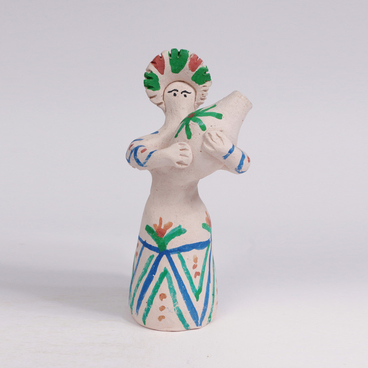This duck, made from light clay, is an ancient Stary Oskol toy. It was created around the 18th century by an unknown craftsman.
In the olden days, the symbol of a bird was very important for pagan cults. Similar images have been found in Slavic burials that date back to the 6th century. In those times people believed that a bird was a servant of the Sun. Moreover, it was perceived as a soul that became free. Sometimes birds were considered messengers of the afterlife, so they were revered as a tribute to the dead. Somewhat later, they began to symbolize the coming spring being called messengers of the Goddess of Mother Earth. Birds were also associated with the signs of three elements — fire, air and earth.
Among the birds, people especially singled out the image of ‘utushka’ (diminutive of ‘utka’, which means ‘duck’) that was an ancient Slavic symbol of water with purifying power. It was believed that the duck was associated with all four elements, and therefore it was perceived as a much stronger amulet than just a bird. In the 16th — 18th centuries, many duck-shaped whistles were made in Stary Oskol. Some of them were painted with ocher. According to archaeologists, similar birds were present in almost all Russian crafts of that time.
The technology used by the masters who created ancient ‘duckies’ is well known. Its name translates as ‘the reversed carrot’. The process goes as follows: a large carrot-shaped cone is rolled out of a clay ball for the future toy’s body, as well as a small sausage-like form for the head and neck. A large cone-shaped cavity is created in the “carrot”, which, when finished, serves as a resonator chamber for the whistle. Then the carrots are set aside, and the sausage is taken, from which the neck and head of the bird are formed. Then the carrot cone is flattened to the same thickness as the sausage, and the two parts are connected. Before attaching the neck to the base of the toy, the junction is moistened with water.
Using this technology, there is often not enough clay in some places — then it is added from the general stock, which, however, does not affect the strength of the joint. After that, the masters finally form the head of the toy and attach the legs to the body. In addition to the legs, the duck usually rests on the tail — it also acts as a mouthpiece for the whistle.
In the olden days, the symbol of a bird was very important for pagan cults. Similar images have been found in Slavic burials that date back to the 6th century. In those times people believed that a bird was a servant of the Sun. Moreover, it was perceived as a soul that became free. Sometimes birds were considered messengers of the afterlife, so they were revered as a tribute to the dead. Somewhat later, they began to symbolize the coming spring being called messengers of the Goddess of Mother Earth. Birds were also associated with the signs of three elements — fire, air and earth.
Among the birds, people especially singled out the image of ‘utushka’ (diminutive of ‘utka’, which means ‘duck’) that was an ancient Slavic symbol of water with purifying power. It was believed that the duck was associated with all four elements, and therefore it was perceived as a much stronger amulet than just a bird. In the 16th — 18th centuries, many duck-shaped whistles were made in Stary Oskol. Some of them were painted with ocher. According to archaeologists, similar birds were present in almost all Russian crafts of that time.
The technology used by the masters who created ancient ‘duckies’ is well known. Its name translates as ‘the reversed carrot’. The process goes as follows: a large carrot-shaped cone is rolled out of a clay ball for the future toy’s body, as well as a small sausage-like form for the head and neck. A large cone-shaped cavity is created in the “carrot”, which, when finished, serves as a resonator chamber for the whistle. Then the carrots are set aside, and the sausage is taken, from which the neck and head of the bird are formed. Then the carrot cone is flattened to the same thickness as the sausage, and the two parts are connected. Before attaching the neck to the base of the toy, the junction is moistened with water.
Using this technology, there is often not enough clay in some places — then it is added from the general stock, which, however, does not affect the strength of the joint. After that, the masters finally form the head of the toy and attach the legs to the body. In addition to the legs, the duck usually rests on the tail — it also acts as a mouthpiece for the whistle.

